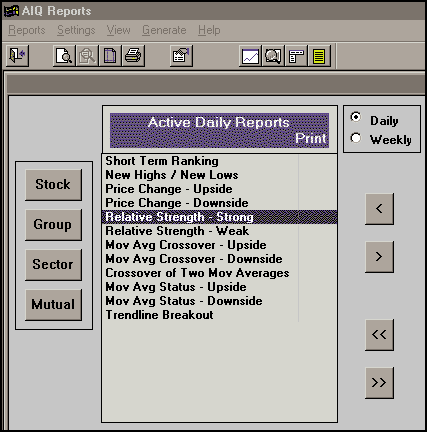MUTUAL FUNDS
A System For Trading Fidelity Select Funds
by Jay Kaeppel
The key techniques for trading stocks, options, and futures can also be applied successfully to mutual funds. Here's a systematic approach to mutual fund trading.
Several keys to investment and trading success are universal; these keys apply to stock, futures, and options trading, and they also apply to trading mutual funds. The first key is to identify opportunities with above-average profit potential. The second is to determine how best to take advantage of those opportunities without taking on too much risk. Achieving the proper balance is of paramount importance; if you never take enough risk, you never allow yourself the opportunity to achieve above-average gains. Conversely, if you take on more risk than you can handle, eventually you will find yourself bailing out at the wrong time. The mutual fund trading system I will examine is designed to achieve such a balance.

FIGURE 1: RELATIVE STRENGTH REPORT. A Reports routine within AIQ's TradingExpert allows the user to determine and measure relative strength. Relative strength can be measured by comparing the 240-day percent change in price for each fund and ranking them if TradingExpert is not available.The Fidelity family of funds offers a unique set of opportunities via their Select group of funds. Each Select fund concentrates its portfolio in a specific industry group or sector -- for example, brokerage, defense, health care, regional banks, and airlines, to mention only a few. These funds offer investors unique opportunities as well as unique risks.
As active stock market participants know, when a sector or industry group gets hot, the stocks in that group can achieve outsized rates of return over relatively short periods. Thus, these Select funds offer investors the opportunity to participate in the sharp runups with a single mutual fund purchase, rather than having to buy a basket of stocks in a particular industry, which can require a fair amount of research and monitoring. More to the point, they offer above-average profit potential.
The bad news? Investing in these concentrated portfolios entails above-average risk. When an industry group falls out of favor, the decline in the prices of stocks in that sector can be swift, severe, and prolonged. The bottom line? Sector fund investing should be approached as a high-risk, high-reward investment. You may make large sums of money if you happen to be in the right funds at the right time, but it is equally important you make certain you donÕt get stuck riding an industry group down as it plummets.
Trading Fidelity Select funds should be viewed as a high-risk, high-reward endeavor. In order to mitigate the risks involved with trading sector funds, investors should not commit more than 15-20% of their investment capital to this type of trading.
OVERVIEW
The starting point for the test of this system is December 30, 1988. At that point in time, there were enough Select funds with enough trading history to begin applying systematic tests. While this gives us 10 years of historical data to work with, many system developers will point out that 10 years is not really all that much history from which to draw definite conclusions. In addition, there has not been a severe bear market of the 1973-74 variety to fully test the system's ability. Nevertheless, the system is conceptually sound and, by the nature of its design, stands a better than even chance of achieving high rates of return in bull markets while also preserving capital during a drawn-out bear market.
This system is ideal for retirement accounts, which allow you to compound profits as you go without paying taxes on it. The recommended portfolio will hold up to five funds at any given point. If fewer than five funds are held at a given time, the balance of the portfolio will be held in cash until new funds that meet the buy criteria can be identified. This gives the system the potential to go heavily into cash in a bear market if most industry groups are declining.
Jay Kaeppel is the director of research at Essex Trading Co. and a registered CTA. He is the codeveloper of Option Pro and Futures Pro trading software, and the author of the Pro-Vest Option Trading Method as well as The Four Biggest Mistakes In Option Trading. He may be reached at 630 682-5780, ext. 225, or via E-mail at essextr@aol.com.
Excerpted from an article originally published in the July 1999 issue of Technical Analysis of STOCKS & COMMODITIES magazine. All rights reserved. © Copyright 1999, Technical Analysis, Inc.
Return to July 1999 Contents